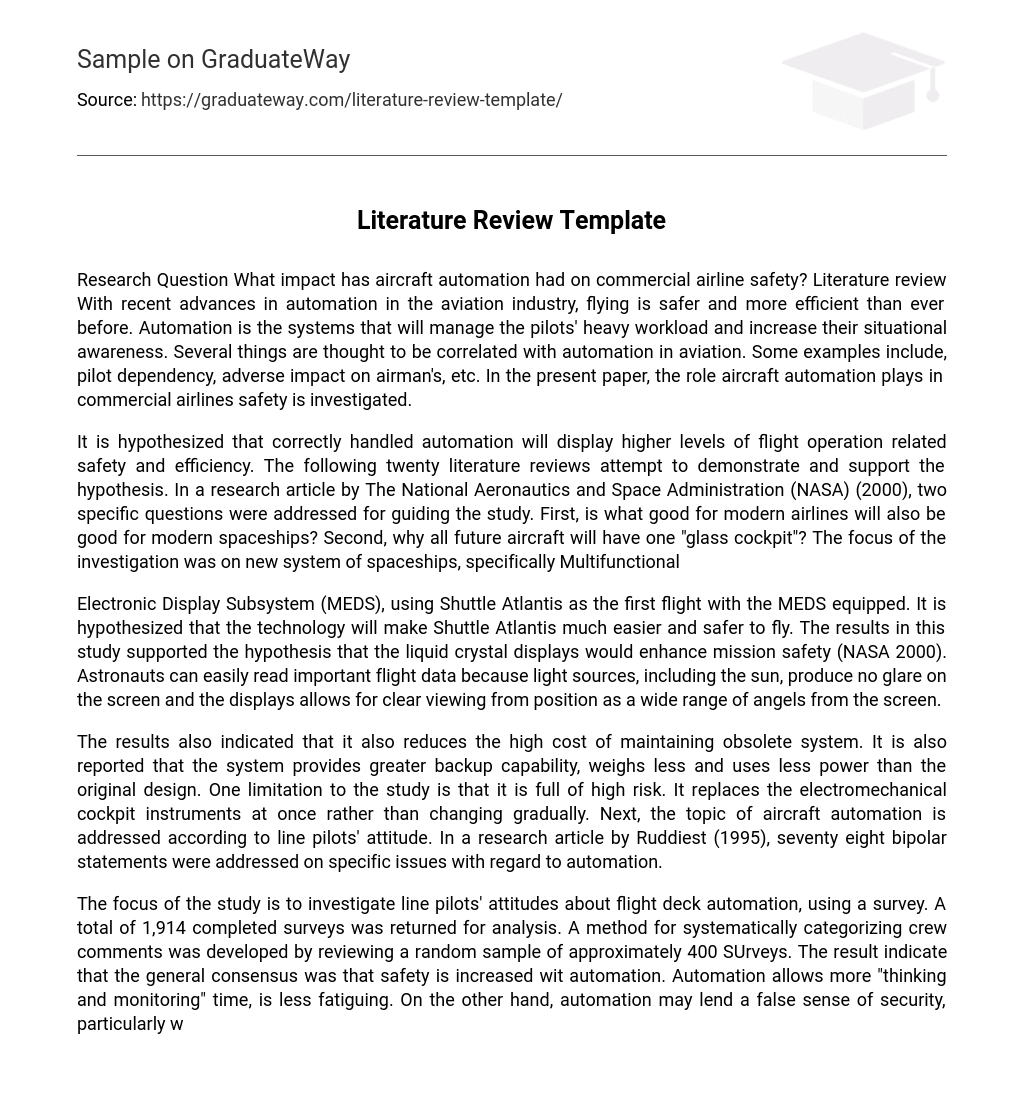Research Question What impact has aircraft automation had on commercial airline safety? Literature review With recent advances in automation in the aviation industry, flying is safer and more efficient than ever before. Automation is the systems that will manage the pilots’ heavy workload and increase their situational awareness. Several things are thought to be correlated with automation in aviation. Some examples include, pilot dependency, adverse impact on airman’s, etc. In the present paper, the role aircraft automation plays in commercial airlines safety is investigated.
It is hypothesized that correctly handled automation will display higher levels of flight operation related safety and efficiency. The following twenty literature reviews attempt to demonstrate and support the hypothesis. In a research article by The National Aeronautics and Space Administration (NASA) (2000), two specific questions were addressed for guiding the study. First, is what good for modern airlines will also be good for modern spaceships? Second, why all future aircraft will have one “glass cockpit”? The focus of the investigation was on new system of spaceships, specifically Multifunctional
Electronic Display Subsystem (MEDS), using Shuttle Atlantis as the first flight with the MEDS equipped. It is hypothesized that the technology will make Shuttle Atlantis much easier and safer to fly. The results in this study supported the hypothesis that the liquid crystal displays would enhance mission safety (NASA 2000). Astronauts can easily read important flight data because light sources, including the sun, produce no glare on the screen and the displays allows for clear viewing from position as a wide range of angels from the screen.
The results also indicated that it also reduces the high cost of maintaining obsolete system. It is also reported that the system provides greater backup capability, weighs less and uses less power than the original design. One limitation to the study is that it is full of high risk. It replaces the electromechanical cockpit instruments at once rather than changing gradually. Next, the topic of aircraft automation is addressed according to line pilots’ attitude. In a research article by Ruddiest (1995), seventy eight bipolar statements were addressed on specific issues with regard to automation.
The focus of the study is to investigate line pilots’ attitudes about flight deck automation, using a survey. A total of 1,914 completed surveys was returned for analysis. A method for systematically categorizing crew comments was developed by reviewing a random sample of approximately 400 SUrveys. The result indicate that the general consensus was that safety is increased wit automation. Automation allows more “thinking and monitoring” time, is less fatiguing. On the other hand, automation may lend a false sense of security, particularly with inexperienced pilots.
Also, it may produce a higher sense of “insecurity’ during an automation failure. These results confirm the hypothesis that introduction of automation technologies has brought a significant impact onto commercial transport flight decks (Ruddiest 1995). One limitation to this study is only 400 out of 1,914 surveys were reviewed for crew comments. The rest had no involvement. Next, the topic of aircraft automation is addressed by examining accident precursors. In the research article by Federal Aviation Administration (FAA) Human Factors Team (1 996), they investigate the cases that are related o automation.
It mainly focused on the interfaces that affect flight plan management. It is predicted that a breakdown in the flight crew and automation interface will affect flight safety. The results indicate that vulnerabilities are shown in flight crew management of automation and situational awareness. The results indicate that the vulnerabilities are there because of a number of interrelated deficiencies in the current aviation system. This is agreeable to what is hypothesized. One limitation of the study is that there may not be universal purport for all of their recommendations.
Next, the topic of aircraft automation is addressed by conducting a survey of experts. In the research article by Funk, Loyal, Wilson, Pint and Minimize (1999), it is hypothesized that many automation human factors issue have been raised. They asked 47 individuals to participate. Of those asked, 36 agreed to complete the survey, and 30 completed surveys were returned. The participants included pilots, industry designers and researchers, and government regulators and researchers. The results support the hypothesis made by the authors, with the exception that automation induced fatigue which leaded to poor performance.
One limitation to the study is the lack of participants. Evidence from experts were obtained from only 30 surveys. Finally, the topic of aircraft automation is addressed using a constructed interview. In a research article by Loyal, Pint, Minimize, Wilson and Funk (1998), a study investigates the current state of airline training for automated aircraft. The questions addressed issues related to the experiences and expertise that the individual responsible for that function would possess. In total 107 people ere interviewed at 12 different organizations between May and December 1997.
Two to four days were sent at each organization while conducting the interviews. The results indicate that automated aircraft have complexities that are not present on traditional aircraft. These complexities create challenges for training development and implementation. One limitation to the study is the act that all the individuals involved were all from major United States airlines and aircraft manufacturers Assessment feedback RARE 3013 Communication and Research Methods Key components of this assignment Comment by marker
Evidence of critical reasoning about the content of the sources used Strength of use of the sources used to justify the appropriateness of the research question Summary comment The Graduate qualities being assessed by this assignment are indicated by an X: x GUI: operate effectively with and upon a body of knowledge GAG: are committed to ethical action and social responsibility GAG: are prepared for lifelong learning GAG: communicate effectively GAG: are effective problem solvers GAG: demonstrate an international perspective GAG:can work both autonomously and collaboratively Assignment grade





